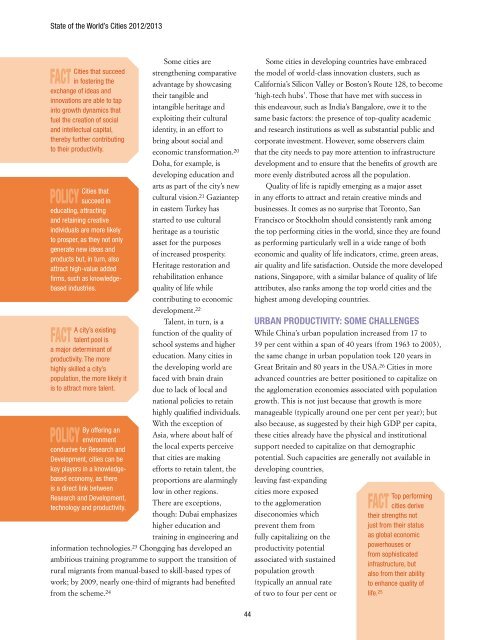state of the world's cities 2012/2013 - United Nations Sustainable ...
state of the world's cities 2012/2013 - United Nations Sustainable ...
state of the world's cities 2012/2013 - United Nations Sustainable ...
You also want an ePaper? Increase the reach of your titles
YUMPU automatically turns print PDFs into web optimized ePapers that Google loves.
State <strong>of</strong> <strong>the</strong> World’s Cities <strong>2012</strong>/<strong>2013</strong>Some <strong>cities</strong> areCities that succeed streng<strong>the</strong>ning comparativeFACT in fostering <strong>the</strong> advantage by showcasingexchange <strong>of</strong> ideas and<strong>the</strong>ir tangible andinnovations are able to tapinto growth dynamics thatintangible heritage andfuel <strong>the</strong> creation <strong>of</strong> social exploiting <strong>the</strong>ir culturaland intellectual capital,identity, in an effort to<strong>the</strong>reby fur<strong>the</strong>r contributing bring about social andto <strong>the</strong>ir productivity.economic transformation. 20Doha, for example, isdeveloping education andarts as part <strong>of</strong> <strong>the</strong> city’s newCities thatpolicy succeed incultural vision. 21 Gaziantepeducating, attractingin eastern Turkey hasand retaining creativestarted to use culturalindividuals are more likely heritage as a touristicto prosper, as <strong>the</strong>y not only asset for <strong>the</strong> purposesgenerate new ideas and<strong>of</strong> increased prosperity.products but, in turn, alsoattract high-value addedHeritage restoration andfirms, such as knowledgebasedindustries.quality <strong>of</strong> life whilerehabilitation enhancecontributing to economicdevelopment. 22Talent, in turn, is aA city’s existingfunction <strong>of</strong> <strong>the</strong> quality <strong>of</strong>fact talent pool isschool systems and highera major determinant <strong>of</strong>productivity. The moreeducation. Many <strong>cities</strong> inhighly skilled a city’s<strong>the</strong> developing world arepopulation, <strong>the</strong> more likely it faced with brain drainis to attract more talent. due to lack <strong>of</strong> local andnational policies to retainhighly qualified individuals.With <strong>the</strong> exception <strong>of</strong>By <strong>of</strong>fering anAsia, where about half <strong>of</strong>policy environmentconducive for Research and<strong>the</strong> local experts perceiveDevelopment, <strong>cities</strong> can be that <strong>cities</strong> are makingkey players in a knowledgebasedeconomy, as <strong>the</strong>re proportions are alarminglyefforts to retain talent, <strong>the</strong>is a direct link betweenlow in o<strong>the</strong>r regions.Research and Development,There are exceptions,technology and productivity.though: Dubai emphasizeshigher education andtraining in engineering andinformation technologies. 23 Chongqing has developed anambitious training programme to support <strong>the</strong> transition <strong>of</strong>rural migrants from manual-based to skill-based types <strong>of</strong>work; by 2009, nearly one-third <strong>of</strong> migrants had benefitedfrom <strong>the</strong> scheme. 24Some <strong>cities</strong> in developing countries have embraced<strong>the</strong> model <strong>of</strong> world-class innovation clusters, such asCalifornia’s Silicon Valley or Boston’s Route 128, to become‘high-tech hubs’. Those that have met with success inthis endeavour, such as India’s Bangalore, owe it to <strong>the</strong>same basic factors: <strong>the</strong> presence <strong>of</strong> top-quality academicand research institutions as well as substantial public andcorporate investment. However, some observers claimthat <strong>the</strong> city needs to pay more attention to infrastructuredevelopment and to ensure that <strong>the</strong> benefits <strong>of</strong> growth aremore evenly distributed across all <strong>the</strong> population.Quality <strong>of</strong> life is rapidly emerging as a major assetin any efforts to attract and retain creative minds andbusinesses. It comes as no surprise that Toronto, SanFrancisco or Stockholm should consistently rank among<strong>the</strong> top performing <strong>cities</strong> in <strong>the</strong> world, since <strong>the</strong>y are foundas performing particularly well in a wide range <strong>of</strong> bo<strong>the</strong>conomic and quality <strong>of</strong> life indicators, crime, green areas,air quality and life satisfaction. Outside <strong>the</strong> more developednations, Singapore, with a similar balance <strong>of</strong> quality <strong>of</strong> lifeattributes, also ranks among <strong>the</strong> top world <strong>cities</strong> and <strong>the</strong>highest among developing countries.Urban Productivity: Some ChallengesWhile China’s urban population increased from 17 to39 per cent within a span <strong>of</strong> 40 years (from 1963 to 2003),<strong>the</strong> same change in urban population took 120 years inGreat Britain and 80 years in <strong>the</strong> USA. 26 Cities in moreadvanced countries are better positioned to capitalize on<strong>the</strong> agglomeration economies associated with populationgrowth. This is not just because that growth is moremanageable (typically around one per cent per year); butalso because, as suggested by <strong>the</strong>ir high GDP per capita,<strong>the</strong>se <strong>cities</strong> already have <strong>the</strong> physical and institutionalsupport needed to capitalize on that demographicpotential. Such capa<strong>cities</strong> are generally not available indeveloping countries,leaving fast-expanding<strong>cities</strong> more exposedTop performingto <strong>the</strong> agglomeration fact <strong>cities</strong> derivediseconomies which<strong>the</strong>ir strengths notprevent <strong>the</strong>m fromjust from <strong>the</strong>ir statusfully capitalizing on <strong>the</strong>as global economicproductivity potentialpowerhouses orfrom sophisticatedassociated with sustainedinfrastructure, butpopulation growthalso from <strong>the</strong>ir ability(typically an annual rateto enhance quality <strong>of</strong><strong>of</strong> two to four per cent or life. 2544





